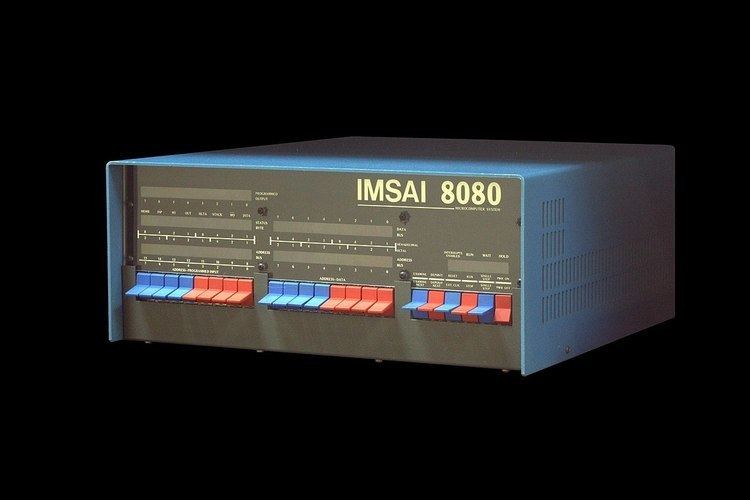Discontinued 1978 (1978) | ||
 | ||
Manufacturer IMS Associates, Inc., laterIMSAI Manufacturing Corporation Release date December 1975; 41 years ago (1975-12) Operating system CPU Intel 8080/8085A @ 2 MHz/3 MHz | ||
The IMSAI 8080 was an early microcomputer released in late 1975, based on the Intel 8080 and later 8085 and S-100 bus. It was a clone of its main competitor, the earlier MITS Altair 8800. The IMSAI is largely regarded as the first "clone" microcomputer. The IMSAI machine ran a highly modified version of the CP/M operating system called IMDOS. It was developed, manufactured and sold by IMS Associates, Inc. (later renamed IMSAI Manufacturing Corp). In total, between 17,000 and 20,000 units were produced from 1975 to 1978.
Contents
History
In May 1972, William Millard started businesses individually as IMS Associates (IMS) in the areas of computer consulting and engineering, using his home as an office. By 1973, Millard founded IMS Associates, Inc. Millard soon found capital for his business, and received several contracts, all for software.
In 1974, IMS was contacted by a client which wanted a "workstation system" that could complete jobs for any General Motors new-car dealership. IMS planned a system including a terminal, small computer, printer, and special software. Five of these work stations were to have common access to a hard disk drive, which would be controlled by a small computer. Eventually product development was stopped.
Millard and his chief engineer Joe Killian turned to the microprocessor. Intel had announced the 8080 chip, and compared to the 4004 to which IMS Associates had been first introduced, the 8080 looked like a "real computer". Full scale development of the IMSAI 8080 was put into action (using the existing Altair 8800's S-100 bus), and by October 1975 an ad was placed in Popular Electronics, receiving positive reactions.
IMS shipped the first IMSAI 8080 kits on 16 December 1975, before turning to fully assembled units. In 1976, IMS was renamed to IMSAI Manufacturing Corporation because by then, they were a manufacturing company, not a consulting firm.
In 1977, IMSAI marketing director Seymour I. Rubinstein paid Gary Kildall $25,000 for the right to run CP/M version 1.3, which eventually evolved into an operating system called IMDOS, on IMSAI 8080 computers. Other manufacturers followed and CP/M eventually became the de facto standard 8-bit operating system.
By October 1979, the IMSAI corporation was bankrupt. The 'IMSAI' trademark was acquired by Thomas "Todd" Fischer and Nancy Freitas (former early employees of IMS Associates), who continued manufacturing the computers under the IMSAI name as a division of Fischer-Freitas Co. Support for early IMSAI systems continues to this day.
IMSAI Series Two
The IMSAI Series Two is a personal computer which combines modern hardware with the original IMSAI 8080 hardware and case, with the original front panel LEDs and switches. The Series Two supports USB and Ethernet and is a co-operative development from Howard Harte (Harte Technologies LLC.) and Thomas Fischer (Fischer-Freitas Company). It has no relation to the original IMS Associates, Inc. (later known as IMSAI Manufacturing Corporation).
Several options are available for the IMSAI Series Two, such as a Mini Drive enclosure for external drives.
VDP series
In 1978/79 IMSAI released the VDP-series, based on the 8085. According to the product description of January 1979, quite some different models were released 32 and 64 K memory, 9" (VDP4x-range) and 12" (VDP8x-range) video display. For example, the VDP-40 had 2 5 1/4" disk drives, a 9" 40 character wide display and a 2 K ROM Monitor all in one cabinet. The built-in keyboard had a 8035 microprocessor and a serial interface to the main board. The VIO-C video board had 2k firmware ROM, 2k character generator ROM with 256 characters and 2 K refresh memory.
The VDP80/1050 was listed in Januari 1979 for $10920 and the VDP-40/64 for $7466.
IMSAI in popular culture
An IMSAI 8080 and an acoustic coupler type modem were among the hacking tools used by the main character in the 1983 movie WarGames [1].
An IMSAI 8080 can also be spotted being used as a prop in an office scene approximately 13 minutes into Sidney Lumet's 2007 crime-drama-thriller film Before the Devil Knows You're Dead.
